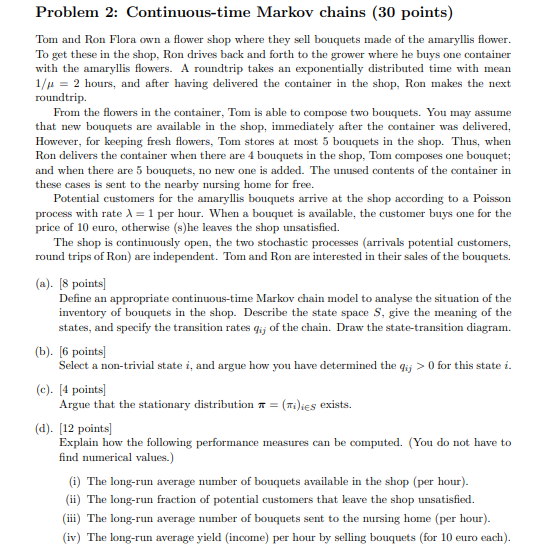
Problem 2: Continuous-time Markov chains (30 points) Tom and Ron Flora own a flower shop where they sell bouquets made of the amaryllis flower. To get these in the shop, Ron drives back and forth to the grower where he buys one container with the amaryllis flowers. A roundtrip takes an exponentially distributed time with mean 1/4 = 2 hours, and after having delivered the container in the shop, Ron makes the next roundtrip. From the flowers in the container, Tom is able to compose two bouquets. You may assume that new bouquets are available in the shop, immediately after the container was delivered, However, for keeping fresh flowers, Tom stores at most 5 bouquets in the shop. Thus, when Ron delivers the container when there are 4 bouquets in the shop, Tom composes one bouquet; and when there are 5 bouquets, no new one is added. The unused contents of the container in these cases is sent to the nearby nursing home for free. Potential customers for the amaryllis bouquets arrive at the shop according to a Poisson process with rate 1 = 1 per hour. When a bouquet is available, the customer buys one for the price of 10 euro, otherwise (s)he leaves the shop unsatisfied. The shop is continuously open, the two stochastic processes arrivals potential customers, round trips of Ron) are independent. Tom and Ron are interested in their sales of the bouquets. (a). [8 points) Define an appropriate continuous-time Markov chain model to analyse the situation of the inventory of bouquets in the shop. Describe the state space S, give the meaning of the states, and specify the transition rates Cij of the chain. Draw the state-transition diagram. (b). [6 points) Select a non-trivial state i, and argue how you have determined the qij >0 for this state i. (c). [4 points) Argue that the stationary distribution = (Ti)ies exists. (d). [12 points) Explain how the following performance measures can be computed. (You do not have to find numerical values.) (i) The long-run average number of bouquets available in the shop (per hour). (ii) The long-run fraction of potential customers that leave the shop unsatisfied. (iii) The long-run average number of bouquets sent to the nursing home (per hour). (iv) The long-run average yield (income) per hour by selling bouquets (for 10 euro each). Problem 2: Continuous-time Markov chains (30 points) Tom and Ron Flora own a flower shop where they sell bouquets made of the amaryllis flower. To get these in the shop, Ron drives back and forth to the grower where he buys one container with the amaryllis flowers. A roundtrip takes an exponentially distributed time with mean 1/4 = 2 hours, and after having delivered the container in the shop, Ron makes the next roundtrip. From the flowers in the container, Tom is able to compose two bouquets. You may assume that new bouquets are available in the shop, immediately after the container was delivered, However, for keeping fresh flowers, Tom stores at most 5 bouquets in the shop. Thus, when Ron delivers the container when there are 4 bouquets in the shop, Tom composes one bouquet; and when there are 5 bouquets, no new one is added. The unused contents of the container in these cases is sent to the nearby nursing home for free. Potential customers for the amaryllis bouquets arrive at the shop according to a Poisson process with rate 1 = 1 per hour. When a bouquet is available, the customer buys one for the price of 10 euro, otherwise (s)he leaves the shop unsatisfied. The shop is continuously open, the two stochastic processes arrivals potential customers, round trips of Ron) are independent. Tom and Ron are interested in their sales of the bouquets. (a). [8 points) Define an appropriate continuous-time Markov chain model to analyse the situation of the inventory of bouquets in the shop. Describe the state space S, give the meaning of the states, and specify the transition rates Cij of the chain. Draw the state-transition diagram. (b). [6 points) Select a non-trivial state i, and argue how you have determined the qij >0 for this state i. (c). [4 points) Argue that the stationary distribution = (Ti)ies exists. (d). [12 points) Explain how the following performance measures can be computed. (You do not have to find numerical values.) (i) The long-run average number of bouquets available in the shop (per hour). (ii) The long-run fraction of potential customers that leave the shop unsatisfied. (iii) The long-run average number of bouquets sent to the nursing home (per hour). (iv) The long-run average yield (income) per hour by selling bouquets (for 10 euro each)







